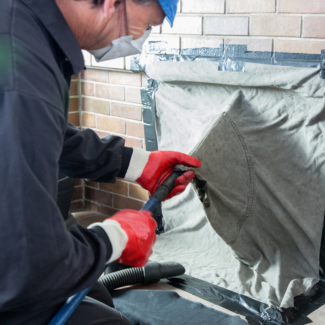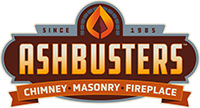When you think of a chimney sweep, it’s possible that you see visions of men with ash-covered faces dancing on rooftops in old London. (Thanks, Mary Poppins.)
The truth is, chimney sweeps have been an important part of chimney maintenance for centuries, cleaning chimneys and protecting families from carbon monoxide poisoning and the dangers of chimney fires. The history of the chimney sweep is long and, like all good history, contains stories that are much of both facts and fiction – let’s explore it.
The Origins of Chimney Sweeping
 No one is quite sure when the profession of chimney sweeping began. Some sources suggest that the profession dates back to ancient Rome, where slaves were tasked with cleaning built-in passages that allowed fires to be kept indoors. Others believe that it began as a profession in medieval Europe, when there was a sharp incline in chimneys being built as an important part of home heating.
No one is quite sure when the profession of chimney sweeping began. Some sources suggest that the profession dates back to ancient Rome, where slaves were tasked with cleaning built-in passages that allowed fires to be kept indoors. Others believe that it began as a profession in medieval Europe, when there was a sharp incline in chimneys being built as an important part of home heating.
What we do know is that chimney sweeping has always been a hazardous profession. There is much on record pointing to young boys as the early arbiters of chimney sweeping. Because they were small enough to fit inside the narrow chimneys, they were tasked to climb up inside with a brush and scrape away at the soot and debris. They would then climb back down and collect the debris, which was often used as a fertilizer.
The work was dirty and dangerous, and the boys who did it were often mistreated by their employers. Often an overseer would take charge over the boys, collecting all of the money, and in return would provide them with often meager housing and just enough food to be able to clean chimneys the next day. Many of these kids later suffered from lung disease due to the constant exposure to soot and other pollutants.
Chimney Sweeping in England
 Chimney sweeping became especially popular in England during the 17th and 18th centuries. The Industrial Revolution brought with it large populations of people living in close quarter houses that were primarily heated by fireplaces with chimneys. At this time, the profession was still largely dominated by young boys, who were often sold into apprenticeships by their families in order to make ends meet.
Chimney sweeping became especially popular in England during the 17th and 18th centuries. The Industrial Revolution brought with it large populations of people living in close quarter houses that were primarily heated by fireplaces with chimneys. At this time, the profession was still largely dominated by young boys, who were often sold into apprenticeships by their families in order to make ends meet.
One of the most famous stories from this time is that of the climbing boys. These were young boys – sometimes as young as 4 years old – specifically trained to climb up chimneys and clean them. They were often small and malnourished and would be forced to climb up chimneys that were only a few feet wide. Many suffered from burns, bruises, and other injuries as a result of their work.
- In 1788, the first of a series of six Chimney Sweepers Acts were passed in England, setting rules for chimney sweeps and making the minimum age 8 years.
- In 1834, the minimum age of a chimney sweep was pushed to 10. Only six years later the Act would be appealed again, allowing 16-year-old boys to be apprentices and the minimum age to climb a chimney became 21.
- In 1875, a tragedy occurred that brought the plight of the climbing boys to public attention. A young boy named George Brewster got stuck in a chimney and died of suffocation. This incident led to public outcry and quickly led to another appeal to the Chimney Sweepers Act. This time, all chimney sweeps were required to carry a certificate of apprenticeship.
Chimney Sweeping in America
The chimney sweep profession was taking off in the early 1800’s in America and, although young boys were being used as sweeps, it was to a much lesser extent than it was in England. Still, there was a lot of injustice and child labor associated with the profession.
One famous chimney icon from American history is Ben Franklin. Franklin was a noted inventor and scientist, but he also owned a successful printing business and was involved in a number of other enterprises.
Franklin noticed that those who experienced a home fire would often experience irreversible financial hardship. This inspired the invention of the Pennsylvania fireplace. This was a cast-iron firebox that was inserted into the fireplace. (Sound familiar?) It needed less wood to burn and provided protection against fire.
In addition to inventing the first fireplace insert, Franklin founded a fire insurance company that is still in business to this day.
Chimney Sweeping in the Modern Era
 Today, the profession of chimney sweeping is still alive and well, although the methods used have changed significantly. Chimney sweeps no longer rely on young boys or climbing boys to do the work, and the use of modern equipment and technology has made the job much safer for the technician and the homeowner.
Today, the profession of chimney sweeping is still alive and well, although the methods used have changed significantly. Chimney sweeps no longer rely on young boys or climbing boys to do the work, and the use of modern equipment and technology has made the job much safer for the technician and the homeowner.
At Ashbusters Nashville our chimney technicians use the best equipment available and take every safety precaution. In addition to their equipment, our techs are highly trained, fully certified, and carry years of experience to every job. This guarantees operational chimneys maintained with little risk of injury.
We’re Here for Nashville Homeowners
Ashbusters Nashville is carrying the torch of our predecessors as we provide inspections, sweepings, repairs, and more to the people of our community. Call us today to get your chimney swept and inspected so that you, too, can rest easier knowing that your chimney is running as safely and efficiently as possible.
Dial (615) 551-2348 or reach out online now.
